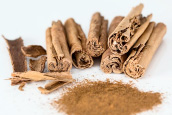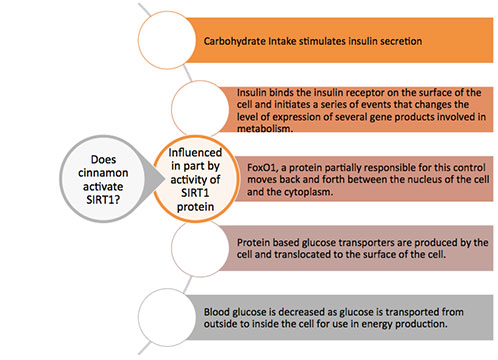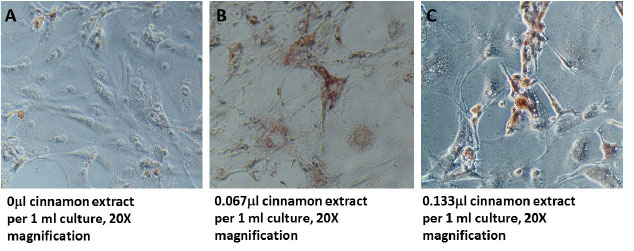
Figure 1. Picture of ground and whole cinnamon
Source: https://www.pexels.com/search/cinnamon/
Cereals with cinnamon, cinnamon sugar, cinnamon buns—from breakfast to dinner, there are many ways we fit this classic spice into our meals. And why not? A sprinkle of cinnamon is delicious! And, as the ancient Egyptians and Chinese might attest, cinnamon also has important health benefits. Traditional uses for cinnamon include the common cold,
indigestion
, and diarrhea. More recently, cinnamon has been linked to reductions in
blood sugar
and
cholesterol
as well as decreased tumor size. Despite all the hype, researchers have a very limited understanding of how cinnamon actually works inside the body. However, new research by Dr. Amy Stockert and Ashley Hoehn at Ohio Northern University has identified specific cellular pathways most impacted by cinnamon, including the connection between
diabetes
and
obesity.
From Science Fair Project to Clinical Trial
For Dr. Amy Stockert, Associate Professor of Biochemistry at Ohio Northern University, this project began as a judge at a local high school science fair. She was intrigued by the project of one participant, Ashley Hoehn, who looked at the impact of cinnamon on blood
glucose.
At the time, Ashley’s grandfather was
pre-diabetic,
and she was motivated to find a way to help him. Dr. Stockert invited Ashely to continue to work on this project in her laboratory. Together they re-designed Ashley’s project into a small controlled trial to see if cinnamon supplements helped control blood glucose in pre-diabetic patients.
Dr. Stockert and Ashley recruited 18 pre-diabetic patients between the ages of 60 and 70 years to participate in a 12-week
clinical trial.
At the time of the study, none of the participants was receiving treatment for this condition. During the study period, all participants maintained a diabetic diet, meaning a diet low in components that raise blood sugar like cane sugar and white flour. In addition, all participants took 1,000 mg of a supplement pill. The treatment group took a cinnamon supplement and the control group took a
placebo
supplement. The participants did not know which supplement they received.
The participants were instructed to record their fasting blood glucose (when they just woke up) and their post-meal blood glucose (just after eating) once per day. Participants also recorded their daily food intake. Participants were asked to maintain their same level of exercise because the researchers wanted to measure the effects of the cinnamon alone, and not cinnamon combined with an altered exercise regimen. For the first three weeks, the participants monitored their blood glucose levels and food intake. From Week 4 to Week 12 (a total of nine weeks), the participants continued to monitor their blood glucose and food intake, and they also took their assigned supplemental pill.
At the end of the 12-week period, Dr. Stockert and Ashley examined their results. “Our findings were really dramatic,” recalls Dr. Stockert. They found the fasting glucose level of the treatment group dropped an average of 19.5 percent and the post-meal glucose dropped an average of 15 percent. This is about the same reduction as expected from prescription medications commonly used to reduce blood glucose levels.
One year after the initial study, Dr. Stockert and Ashley followed up with the original participants. Many of them had still not yet sought treatment for their pre-diabetic condition. Examining the participant blood glucose levels one year later, it was apparent that participants in the treatment group maintained their decrease in blood glucose, suggesting a long-term effect of a short-term dietary supplement.
Cinnamon and Cells
Ashley continued to collaborate with Dr. Stockert for six more years as she received her undergraduate and graduate degrees at Ohio Northern University. Since the initial clinical trial, research in the Stockert lab has focused exclusively on cellular experiments in the laboratory. Clearly cinnamon has an effect on blood glucose. Other researchers have shown that cinnamon also affects cholesterol levels and
lipid
metabolism. Dr. Stockert wants to understand how the cellular mechanisms of fat cells are affected by this ancient spice.
Dr. Stockert hypothesized that cinnamon might affect proteins that control how glucose is transported into muscle and fat cells. One of these proteins is called SIRT1. SIRT1 increases the amount of GLUT4, a protein which transports glucose from the blood stream into the cells. Dr. Stockert hypothesized that an increased production of GLUT4 might increase the amount of glucose transported into muscle and fat cells from the blood stream, resulting in lowered blood glucose levels. In addition, Dr. Stockert hypothesized that SIRT1 might alter the size and shape of mature fat cells.

Figure 2. The effect of SIRT1 on glucose metabolism
Dr. Stockert believes these changes occur through
epigenetics,
a relatively new field of genetic research that describes changes in gene expression (how much protein is produced) that is unrelated to genetic mutation or deletion. Epigenetic changes occur by adding or removing certain parts of a molecule, which affects how tightly strands of DNA are wrapped around themselves and how much protein can be produced.
Computer Modeling
In the laboratory, Dr. Stockert observed the unexpected effects that cinnamon exposure had on individual fat cells. First, Dr. Stockert grew fat cells in different environments: one that was two-dimensional (Figure 3) and one that was three dimensional (Figure 4). When fat cells were exposed to cinnamon, Dr. Stockert observed that the cells growing in the two-dimensional space started to look like they were in a three-dimensional space. The change in fat cell growth patterns due to cinnamon exposure led Dr. Stockert to suspect that epigenetics might be at play.

Figure 3. In monolayer (2D) cells were grown in expansion media supplemented with 0 (A), 0.0167 (B), or 0.133 (C) ml of aqueous cinnamon extract per 1 ml of culture. Following growth, cells were fixed and stained with oil red O. Cells with cinnamon extract have increased lipid content but it was not yet formed round adipocyte like cells (B). When doubling the amount of cinnamon extract, the lipid droplets begin to aggregate and round adipocyte like cells are evident (C). Cultures were also tested for viability and there was no indication of cell death at these concentrations. (Unpublished, Stockert Lab Group)
In the scientific literature, Dr. Stockert found one frequently studied molecule was the phenol compound known as resveratrol. This compound is found in berries, red wine, and dark chocolate, among other foods. Research suggests that resveratrol has an epigenetic effect on the SIRT1 protein, and, while the evidence is mixed, some studies have shown that resveratrol can help reduce blood pressure and risk of
heart disease.
Although resveratrol is not present in cinnamon, cinnamon does contain several other phenol compounds. To test whether the phenols present in cinnamon might affect SIRT1 like resveratrol does, Dr. Stockert used a computer model to simulate how the phenols might bind to cinnamon. The computer chooses potential binding sites on the protein and different orientations of the bound molecules to determine which SIRT1 – cinnamon component molecule would be the most stable. This is the phenol compound that Dr. Stockert would expect to have the greatest effect on SIRT1, and she found that this effect was significantly stronger than that of resveratrol.
Epigenetic Changes
When Dr. Stockert was growing fat cells in the laboratory, she made another unusual observation. She found that cells pre-programmed to become fat cells would not become fat cells when exposed to cinnamon. This observation led Dr. Stockert to hypothesize that cinnamon affected a
transcription factor —
a class of proteins that control how much of their target protein is produced. Since SIRT1 is known to affect the glucose transporter GLUT4, Dr. Stockert hypothesized that the affected transcription factor might be FOX01, which controls the production of GLUT4.
This can occur through epigenetics. When SIRT1 is activated by phenols in cinnamon, it alters the genetic sequence of FOX01, causing the transcription factor to wind more tightly and produce more of its target protein GLUT4. Dr. Stockert hypothesized that the increased production of GLUT4 glucose transporters might lead to an increase in glucose that can be transported into cells from the blood stream, resulting in lowered blood glucose levels.
Connecting Diabetes and Obesity
Finally, Dr. Stockert observed that fat cells in the laboratory actually shrunk in size when exposed to cinnamon. After performing experiments to better understand these changes, Dr. Stockert hypothesized that the changes in cell size are due to the effects of SIRT1 on the
cytoskeleton
of the cell. In particular, SIRT1 causes the cytoskeleton to become thinner, allowing fat molecules to be released from the cell more easily.

Figure 4. Panel A shows cells not treated with cinnamon. Panel B is a representative culture treated with cinnamon extract (3D). Both cultures (A and B) were grown from the same batch of cells, were plated at identical cell density, and were photographed at identical magnification (20X) and identical field. Average diameter of cells treated as in panel A. In panel C, Comparison of the diameter of cells treated with bovine calf serum (BCS), fetal bovine serum (FBS), or fetal bovine serum with cinnamon extract. Cinnamon treated cell size is significantly different than any of the other samples including vehicle control, which was diluted relative to the normal serum concentrations to the same extent that the cinnamon cultures were diluted. (Unpublished, Stockert Lab Group)
Scientists and clinicians know that people who have been overweight for a long period of time have more difficulty losing weight. This is because mature fat cells become larger, and it is harder to release the fat molecules that they contain inside. Dr. Stockert believes that cinnamon might help people who have been overweight for a long time lose weight by shrinking the size of fat cells, making it easier for those fat molecules to be used in the body. This hypothesis will be tested in future experiments.
Although Dr. Stockert’s hypothesis about cinnamon and weight loss has not yet been tested in the laboratory, the hypothesis itself has important scientific implications. For decades scientists have observed a connection between diabetes and obesity, but the mechanisms behind this link remain unclear. Cinnamon and its effects on SIRT1 offer one potential connection between these two diseases, because SIRT1 affects both glucose metabolism and lipid metabolism.
Conclusion
Cinnamon is tasty. It also may have powerful effects on the body that we are just beginning to understand. In a clinical trial, Dr. Stockert and her student Ashley Hoehn showed that cinnamon consumption helped pre-diabetic patients maintain normal blood glucose levels, and that these effects were observed even one year after the initial study.
In the laboratory, Dr. Stockert continues to test three interlinking hypotheses that might explain how the phenol compounds in cinnamon may have an epigenetic effect on both glucose and lipid metabolism by altering the expression of the protein SIRT1. In glucose metabolism, SIRT1 increases the amount of the GLUT4 glucose transporter produced by altering the structure of its transcription factor FOX01. In lipid metabolism, SIRT1 alters the size and shape of mature fat cells to that the fat molecules can be more easily released.
Ongoing experiments with cinnamon compounds in the laboratory will provide evidence to either support or refute Dr. Stockert’s current hypothesis, and help her develop new ones.
Dr. Amy Stockert is an Associate Professor of Biochemistry at Ohio Northern University where she studies the effects of enzymes and other proteins on cellular function. When not in the laboratory, Dr. Stockert enjoys distance running and spending time with her family.
Ashley Hoehn was recently married and is working as a pharmacist at Discount Drug in Delphos, Ohio.
For More Information:
- Hoehn, Ashley, and Amy Stockert. 2012. “The effects of cinnamomum cassia on blood glucose values are greater than those of dietary changes alone.” ” Nutrition and Metabolic Insights, 5:77-83.
To Learn More:
Diabetes
- American Diabetes Association.
http://www.diabetes.org/diabetes-basics/?loc=db-slabnav
- National Institute of Diabetes and Digestive and Kidney Diseases.
https://www.niddk.nih.gov/health-information/diabetes/overview/what-is-diabetes
- Centers for Disease Control and Prevention.
https://www.cdc.gov/diabetes/home/index.html
- World Health Organization.
http://www.who.int/topics/diabetes_mellitus/en/
Obesity
- Centers for Disease Control and Prevention.
https://www.cdc.gov/obesity/
- American Heart Association. .
http://www.heart.org/HEARTORG/HealthyLiving/WeightManagement/Obesity/Obesity-Information_UCM_307908_Article.jsp#.WdGBrsiGM2w
- World Health Organization.
http://www.who.int/topics/obesity/en/
- Obesity Society.
http://www.obesity.org/obesity/resources/facts-about-obesity/what-is-obesity
Written by Rebecca Kranz with Andrea Gwosdow, PhD at www.gwosdow.com

